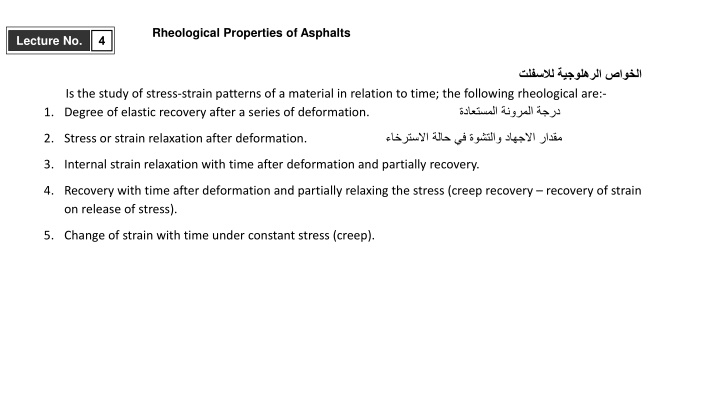
Rheological Properties of Asphalts: Stress-Strain Patterns and Types
Dive into the study of rheological properties of asphalts focusing on stress-strain patterns over time. Explore topics like elastic recovery, stress relaxation, and different types of asphalt behavior including Sol, Sol-Gel, and Gel types. Understand the flow characteristics, viscosity changes, and deformation behaviors of asphalts under various conditions.
Download Presentation

Please find below an Image/Link to download the presentation.
The content on the website is provided AS IS for your information and personal use only. It may not be sold, licensed, or shared on other websites without obtaining consent from the author. If you encounter any issues during the download, it is possible that the publisher has removed the file from their server.
You are allowed to download the files provided on this website for personal or commercial use, subject to the condition that they are used lawfully. All files are the property of their respective owners.
The content on the website is provided AS IS for your information and personal use only. It may not be sold, licensed, or shared on other websites without obtaining consent from the author.
E N D
Presentation Transcript
Rheological Properties of Asphalts Lecture No. 4 Is the study of stress-strain patterns of a material in relation to time; the following rheological are:- 1. Degree of elastic recovery after a series of deformation. 2. Stress or strain relaxation after deformation. 3. Internal strain relaxation with time after deformation and partially recovery. 4. Recovery with time after deformation and partially relaxing the stress (creep recovery recovery of strain on release of stress). 5. Change of strain with time under constant stress (creep).
Rheological Types of Asphalts:- Various degree of dispersion of asphaltenes gives rise to three following; 1. Sol (Newtonian) type:- viscous part type show purely viscous flow with no elastic effect viscosity is independent of shearing stress or time; deformation per unit time is proportional to shearing stress. These asphalts are characterized by susceptibility to temperature change. ( ) This , . 1. Sol Gel (Viscoelastic Asphalt):- This type is differentiated from the Sol type by the presence of elastic deformation; after a deformation the viscosity is practically independent of stress. At constant shearing stress the rate of deformation decreases at the beginning and recover particle elasticity after stress removal. . - , . 1. Gel or Elastic Asphalts (non-Newtonian) This type of asphalt is characterized by a retarded elastic deform ability with considerable permanent deformation but no permanent viscous deformation. .
- a. The gel asphalt show a low degree of consistency change with change in temperature b. Deformation increases rapidly with increasing shearing stress, and thixotropic effects. c. Internal structure is destroyed with increasing shearing stress d. Resilience decreases much more after continued deformation than in the case of the sol-gel types Rheological properties of Gel asphalts
1. Newtonian flow (viscous flow); flow directly when load applied : - a. The curve passes through origin. b. Newtonian flow behavior is slope. c. Asphalt heating > softening point. 1. Non-Newtonian Flow:- no direct flow after yield stress : - a. The curve does not pass through origin but somewhat along to shearing stress > yield stress. b. At low temperature asphalt behave as non-Newtonian. Types of Flow:-
Pesdo-Plastic Flow (viscuss, but effect) Dilatant Flow Thixo-tropic Flow ( Touch +change) Plastic Flow with elastic (Oxidized asphalt) Yield Stress Shear stress Shear stress Shear stress Shear stress Shear strain Shear strain Viscosity Shear strain I Shear stress Shear stress Shear strain Viscosity II Shear stress Viscosity Type of flow where consistency curve starts at the origin (no yield value) but the rate of flow increases faster than in a linear with shear stress. Dispersions that are Newtonian liquid at low rates of shear but whose viscosity increasing rate of shear above a minimum critical value A state of change of a gel to sol state after applying forces at constant temp. or property of a body by virtue of which the ration of shear to rate of deformation is reduced by previous deformation. shearing temporarily ) ( . I) Break down of the structure under shear until homogenous consistency. II) At rest; build up structure forming Gel.






















